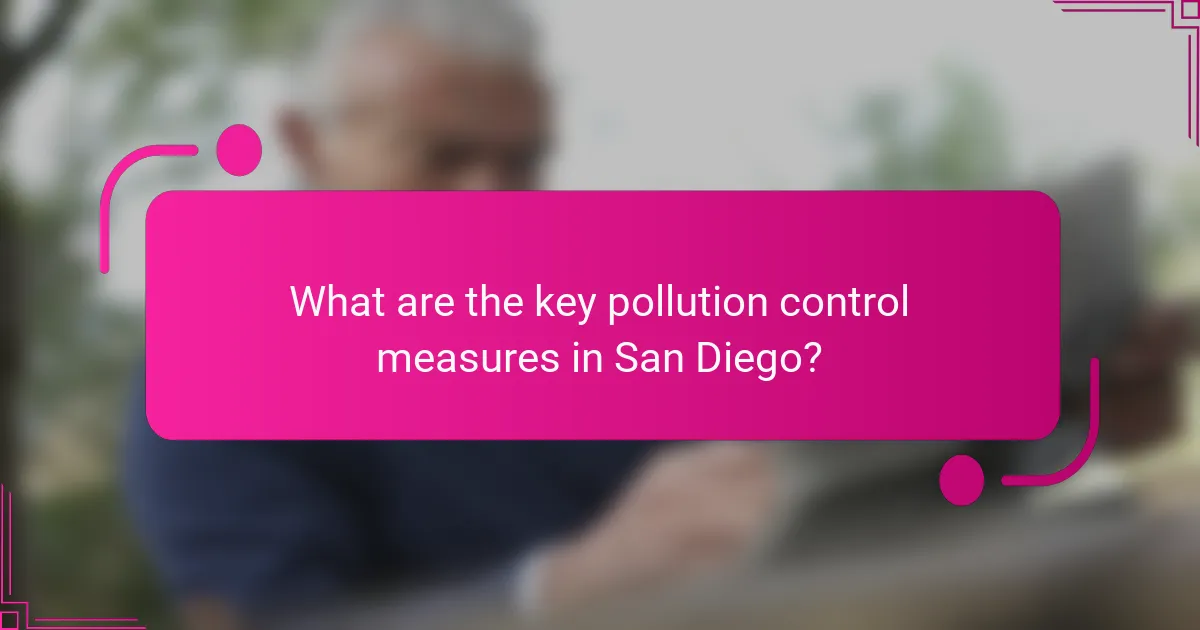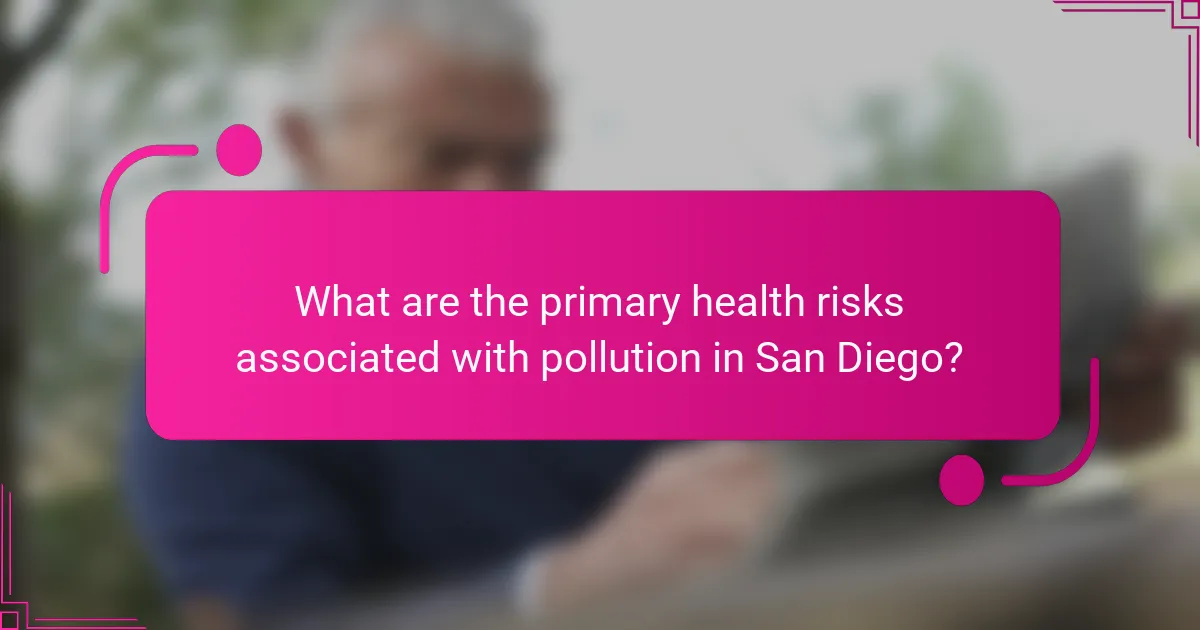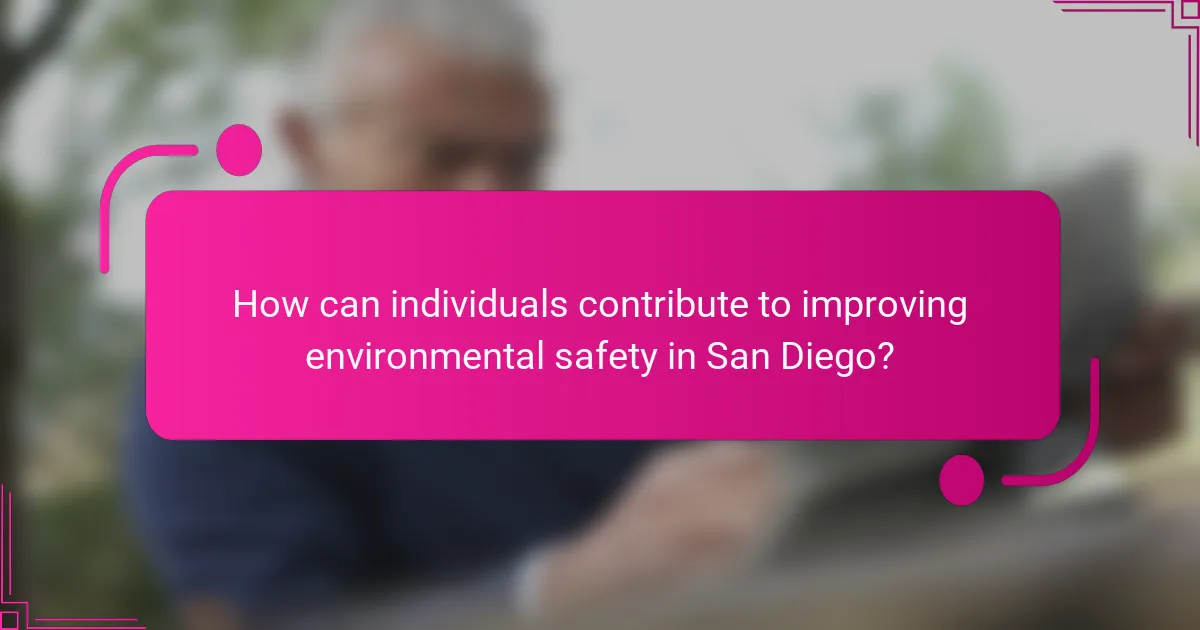
What are the key pollution control measures in San Diego?
San Diego implements several key pollution control measures. These include stringent air quality regulations enforced by the San Diego Air Pollution Control District. The district monitors emissions from vehicles and industrial sources. Additionally, San Diego promotes the use of renewable energy sources. The city has invested in public transportation to reduce vehicle emissions. Water quality is maintained through the Clean Water Program. This program manages stormwater runoff and wastewater treatment. San Diego also engages in community education on pollution prevention. These measures collectively aim to enhance environmental safety and public health.
How do these measures impact community health?
Pollution control measures significantly improve community health. These measures reduce harmful emissions from industrial sources and vehicles. By lowering air pollution levels, respiratory diseases like asthma decrease. Improved air quality also leads to lower rates of cardiovascular issues. Studies show that cities with strict pollution controls have healthier populations. For example, a study from the American Journal of Public Health found that reducing particulate matter can increase life expectancy. Overall, effective pollution control enhances the quality of life in communities.
What specific pollutants are targeted by these measures?
The specific pollutants targeted by these measures include particulate matter, nitrogen oxides, sulfur dioxide, and volatile organic compounds. Particulate matter contributes to respiratory issues and is a primary concern in urban areas. Nitrogen oxides are linked to smog formation and respiratory problems. Sulfur dioxide can cause acid rain and respiratory distress. Volatile organic compounds are associated with air quality deterioration and health risks. These pollutants significantly impact community health and environmental quality in San Diego.
How effective are these measures in reducing pollution levels?
These measures are effective in reducing pollution levels in San Diego. Various initiatives have led to significant improvements in air and water quality. For example, the implementation of stricter vehicle emissions standards has reduced nitrogen oxide emissions by 50% since 1990. Additionally, the expansion of public transportation options has decreased reliance on personal vehicles. This shift has contributed to a 30% reduction in greenhouse gas emissions over the past decade. Furthermore, community engagement programs have raised awareness about pollution sources, leading to more responsible waste disposal practices. Studies indicate that these combined efforts have resulted in a measurable decline in respiratory issues among residents.
What role do local regulations play in pollution control?
Local regulations are crucial in pollution control as they set specific standards and limits for emissions and waste management. These regulations help to protect air and water quality in communities. Local governments enforce compliance through permits and inspections. They also provide guidelines for industries to follow, reducing harmful pollutants. For example, the San Diego Air Pollution Control District implements regulations to limit vehicle emissions. This leads to improved public health outcomes by decreasing respiratory diseases linked to pollution. Overall, local regulations play a vital role in mitigating environmental risks and protecting community health.
Which agencies are responsible for enforcing these regulations?
The agencies responsible for enforcing pollution control regulations in San Diego include the San Diego Air Pollution Control District (SDAPCD) and the California Department of Fish and Wildlife (CDFW). The SDAPCD regulates air quality and ensures compliance with air pollution laws. The CDFW oversees the protection of wildlife and habitats, addressing pollution impacts on ecosystems. Additionally, the Environmental Protection Agency (EPA) plays a crucial role at the federal level, enforcing regulations that affect air and water quality. These agencies work together to enforce laws aimed at reducing pollution and protecting community health.
How do community organizations contribute to regulatory efforts?
Community organizations contribute to regulatory efforts by advocating for environmental policies. They mobilize local residents to raise awareness about pollution issues. These organizations often gather data on environmental health risks in their communities. They present this information to regulatory agencies to influence decision-making. Community organizations also participate in public hearings and comment periods. Their involvement ensures that community voices are heard in regulatory processes. Studies show that community engagement leads to more effective regulatory outcomes. For instance, the California Environmental Protection Agency acknowledges the role of community input in shaping regulations.

What are the primary health risks associated with pollution in San Diego?
The primary health risks associated with pollution in San Diego include respiratory issues, cardiovascular diseases, and neurological effects. Air pollution from vehicles and industrial sources contributes to these health problems. For instance, particulate matter can lead to asthma and chronic obstructive pulmonary disease (COPD). According to the American Lung Association, San Diego has received poor air quality ratings, impacting public health. Additionally, exposure to pollutants like lead and mercury can cause developmental issues in children. The California Environmental Protection Agency has reported increased hospital admissions due to pollution-related conditions. Therefore, pollution poses significant health risks to the San Diego community.
What populations are most vulnerable to these health risks?
Low-income communities are most vulnerable to health risks associated with pollution. These populations often live near industrial areas, increasing exposure to hazardous pollutants. Additionally, children are particularly susceptible due to their developing bodies and respiratory systems. The elderly also face heightened risks from pollution-related health issues. Individuals with pre-existing health conditions, such as asthma or cardiovascular diseases, are more likely to experience severe effects. Studies show that marginalized communities often lack access to healthcare resources, exacerbating their vulnerability. The California Office of Environmental Health Hazard Assessment highlights that socioeconomic factors significantly influence health outcomes in these populations.
How does air quality affect respiratory health in children?
Air quality significantly impacts respiratory health in children. Poor air quality can lead to increased rates of asthma and respiratory infections. Children are particularly vulnerable due to their developing lungs and higher respiratory rates. Exposure to pollutants like particulate matter and ozone can cause inflammation in the airways. A study by the California Air Resources Board found that children living near highways have higher asthma rates. Furthermore, long-term exposure to poor air quality can result in reduced lung function. Protecting children from air pollution is essential for their respiratory health.
What long-term health effects are linked to water pollution?
Long-term health effects linked to water pollution include chronic diseases and developmental issues. Exposure to contaminated water can lead to gastrointestinal diseases, reproductive problems, and neurological disorders. Heavy metals such as lead and mercury in polluted water are associated with cognitive impairments and kidney damage. Persistent organic pollutants can disrupt endocrine functions, potentially leading to cancers. According to the World Health Organization, nearly 2 billion people rely on contaminated drinking water, increasing their risk of these health issues. Studies have shown that communities near polluted water sources experience higher rates of health problems. For instance, a study published in Environmental Health Perspectives found correlations between water pollution and increased incidences of asthma and other respiratory conditions.
What strategies are in place to educate the community about health risks?
Community education about health risks is facilitated through various strategies. These strategies include workshops, informational campaigns, and partnerships with local organizations. Workshops provide hands-on learning experiences about specific health risks. Informational campaigns utilize social media and public service announcements to reach a wider audience. Partnerships with local organizations enhance resource sharing and community engagement. Schools often incorporate health education into their curricula, promoting awareness among younger populations. Local health departments also distribute educational materials and conduct health screenings. These efforts aim to improve public understanding of health risks and promote preventive measures.
How can community members access information on pollution levels?
Community members can access information on pollution levels through various online platforms. The Environmental Protection Agency (EPA) provides real-time air quality data on its website. Local government websites also publish pollution reports and updates. Additionally, community organizations often share information via newsletters and social media. Mobile apps such as AirNow offer air quality monitoring directly to users. Public libraries may have resources and databases on environmental data. Local news outlets frequently report on pollution issues in the area. These sources ensure that residents stay informed about pollution levels affecting their health.
What resources are available for those affected by pollution?
Resources available for those affected by pollution include local health departments, environmental organizations, and community support groups. The San Diego County Health and Human Services Agency provides information on health impacts from pollution. The Environmental Health Coalition offers advocacy and education for affected communities. The California Air Resources Board monitors air quality and provides resources for public health. Additionally, the U.S. Environmental Protection Agency offers support programs for pollution-related health issues. These organizations provide critical information, assistance, and advocacy for those impacted by pollution.

How can individuals contribute to improving environmental safety in San Diego?
Individuals can contribute to improving environmental safety in San Diego by reducing waste and recycling. Proper waste management decreases landfill overflow. Recycling materials like paper, glass, and plastics conserves resources.
Additionally, residents can use public transportation or carpool. This reduces greenhouse gas emissions. Planting trees and maintaining green spaces also enhances air quality. Supporting local environmental organizations amplifies community efforts.
Participating in beach cleanups helps remove pollution from coastal areas. Educating others about environmental issues fosters a culture of sustainability. Implementing energy-efficient practices in homes decreases overall energy consumption.
These actions collectively contribute to a safer and healthier environment in San Diego.
What are some practical steps residents can take to reduce pollution?
Residents can reduce pollution by adopting several practical steps. They can use public transportation, reducing vehicle emissions. Carpooling or biking also lowers air pollution. Implementing energy-efficient appliances cuts down on energy consumption. Residents should engage in recycling to minimize waste. Planting trees enhances air quality and absorbs carbon dioxide. Using eco-friendly products reduces harmful chemicals in the environment. Conserving water decreases the energy needed for water treatment. Supporting local clean-up initiatives fosters community involvement in pollution reduction.
How can community involvement enhance pollution control efforts?
Community involvement can significantly enhance pollution control efforts by fostering local awareness and participation. Engaged communities can identify pollution sources more effectively. They can also advocate for stricter regulations and support local initiatives. Studies show that community-led programs often result in improved environmental practices. For example, a 2018 report by the Environmental Protection Agency indicated that community engagement led to a 30% reduction in local pollution levels in several U.S. cities. Additionally, active community participation can lead to increased funding for pollution control projects. Overall, community involvement creates a sense of ownership and responsibility, driving collective action towards cleaner environments.
What best practices should be followed for maintaining community health?
Best practices for maintaining community health include promoting clean air and water, ensuring access to healthcare, and encouraging healthy lifestyles. Clean air and water reduce the risk of respiratory and waterborne diseases. Access to healthcare enables early detection and treatment of health issues. Encouraging healthy lifestyles, such as regular exercise and balanced nutrition, improves overall well-being. Community engagement in health initiatives fosters awareness and participation. Regular health screenings and vaccinations protect against preventable diseases. Collaboration with local organizations enhances resource availability. Implementing policies that reduce pollution contributes to a healthier environment.
How can residents advocate for better environmental policies?
Residents can advocate for better environmental policies by organizing community meetings. These gatherings allow residents to discuss environmental concerns and propose solutions. Engaging with local government officials is crucial. Residents can schedule meetings to present their ideas and request policy changes. Joining or forming advocacy groups amplifies their voice. Collaborative efforts can lead to larger campaigns for policy reform. Utilizing social media platforms can raise awareness and mobilize support. Sharing information about environmental issues encourages community involvement. Participating in public hearings provides residents an opportunity to voice their opinions. Research shows that community advocacy can influence policy decisions significantly.
What initiatives can individuals join to support pollution reduction?
Individuals can join local environmental organizations to support pollution reduction. Organizations like Surfrider Foundation and San Diego Coastkeeper focus on clean water initiatives. They often organize beach cleanups and educational workshops. Individuals can participate in community recycling programs. These programs help reduce waste and promote sustainable practices. Joining advocacy groups can also amplify efforts to influence policy changes. Many of these groups work on local legislation to reduce emissions. Volunteering for tree planting initiatives contributes to air quality improvement. Engaging in carpooling or using public transport reduces vehicle emissions. Each of these initiatives plays a role in decreasing pollution levels in San Diego.
San Diego Environmental Safety focuses on the city’s pollution control measures and their impact on community health. Key initiatives include stringent air quality regulations, promotion of renewable energy, and community education programs aimed at reducing harmful emissions. The article highlights the specific pollutants targeted, the effectiveness of local regulations, and the role of community organizations in advocating for environmental policies. It also addresses the health risks associated with pollution, particularly for vulnerable populations, and outlines practical steps residents can take to contribute to pollution reduction efforts.